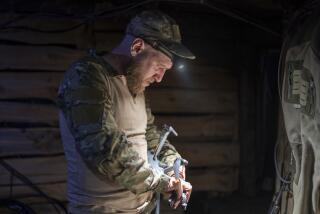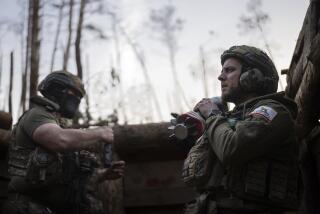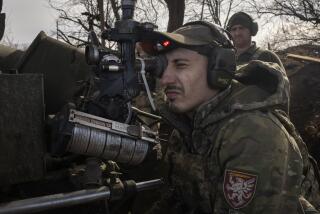Soviets to Cut Back Armed Forces in Radical Reform
MOSCOW — The new Soviet defense minister, committing himself to “radical, fundamental reforms” of the country’s military, announced plans Friday to scale down the Red Army, turning it into a smaller, more professional force and halving the time served by conscripts.
Air Marshal Yevgeny I. Shaposhnikov, appointed after the collapse of last month’s conservative coup d’etat , said Soviet armed forces will be cut by one-quarter to about 3 million soldiers, sailors and fliers as a result of a treaty reducing conventional forces in Europe.
He told a news conference that the Soviet Union is eager to negotiate even sharper reductions but wants to see similar cuts by its neighbors, particularly in the North Atlantic Treaty Organization.
“Reciprocity would make everything easier,” he said, offering the West a long-sought opening to reduce Soviet troop levels--and this time with an ally at the Defense Ministry here.
“I think that the NATO leadership is already responding to a certain degree to our declarations and our aspirations,” Shaposhnikov said. “There are specific, concrete steps to reduce arms in Europe and the United States.”
A program of far-reaching military reforms is being prepared for approval by the State Council, which is currently the country’s governing body, and should be in effect by January, 1992, Shaposhnikov said. One proposal is the appointment of civilians to top Defense Ministry posts.
“We are talking about radical reforms,” Shaposhnikov said, underscoring the point by declaring his willingness and that of his colleagues at the Defense Ministry to turn over control to civilians.
Speaking with reporters after the 75-minute news conference, his first as defense minister, Shaposhnikov, 49, was asked whether he would step aside for a civilian appointee.
“Immediately,” he answered.
Was he willing to quit the air force and run the ministry as a civilian?
“If asked, tomorrow,” he replied. “Civilian political control is right and proper.”
He made the point by wearing civilian clothes for the news conference--a fashionable, dark-gray suit, a dazzling white shirt and a blue-and-red-striped tie. His predecessors always wore their brown uniforms, replete with tunics covered with medals and bright red stripes down their trouser legs.
A Cossack from the Rostov region of southern Russia, Shaposhnikov joined the air force in 1959 at age 17. His father, then an army sergeant, was killed in the last week of World War II when Shaposhnikov was 3.
Shaposhnikov was appointed commander in chief of the Soviet air force in July, 1990--the youngest officer to hold the post in two generations.
Shaposhnikov refused to join the conservative conspiracy to oust Soviet President Mikhail S. Gorbachev last month, although Marshal Dmitri T. Yazov, then the Soviet defense minister, was one of its leaders, and many top commanders backed it.
Instead, Shaposhnikov kept the air force out of action and on the ground, then began to build support among the military for a counter-coup if force were required. When the conspiracy began to crumble, he was a key figure in getting commanders to obey orders to return the troops to their barracks.
“This was a state coup, not a military one,” he said. “The military did not replace the authorities anywhere. The army remained united with the people and therefore deserves respect.”
Ticking off the reforms of the last month, Shaposhnikov said Communist Party units had been removed from the armed forces under a Gorbachev decree. Many political officers, traditionally the No. 2 under each commander, are being withdrawn, he said, and their functions are being changed for those who remain.
Major changes are already being made, he said, in the Soviet defense budget.
(Shaposhnikov was referring to the Defense Ministry’s published budget, which for 1991 totaled $154 billion at the official exchange rate. Actual military spending, however, consumes an estimated one-quarter of the Soviet gross national product, according to Soviet economists.)
Much of the money allocated for buying equipment next year will, instead, go for pay increases averaging 41% for Soviet officers--enlisted men receive only token pay--and 60% of capital construction funds will go for housing rather than bases.
“It is not the function of the defense minister to cut the budget,” Shaposhnikov said. “In fact, it is hard with all the new priorities we have. What I am doing is redeploying the money.”
Shaposhnikov said the reforms now being drawn up would reduce a conscript’s period of service from two years to one and permit most of them to serve that time in their home regions. The Soviet armed forces at present have about 2.7 million conscripts out of a total of 4.2 million men and women.
Professional soldiers, sailors and fliers would be recruited on a volunteer basis, filling specialized jobs and receiving higher pay.
After decades of viewing the West, particularly the United States, as their potential adversary, the Soviet armed forces no longer have an “enemy” to focus on, Shaposhnikov said.
“I do not see potential adversaries at present,” he said, “but a military threat has not been entirely eliminated since there remain large groupings of armed forces, some leaders in the world have aggressive aspirations and the solution of some political problems by force has not been ruled out.
“As long as this situation remains, we should maintain our armed forces at a proper level.”
As part of the effort to reconstitute the Soviet Union as a confederation with political power remaining with its constituent states, the country’s defense will require close collaboration of the republics, Shaposhnikov said.
Last week, they agreed on maintaining a united armed forces.
Although the Ukraine and other republics have sought to raise their own armies, Shaposhnikov said that these would probably not amount to more than 3,000 troops each and serve largely as republic guards.
As before, nuclear weapons will be controlled by the central government, Shaposhnikov said, “but republic presidents should know what weapons are located on their territory and how they are being used.”
He said the Soviet armed forces would not intervene in the country’s civil disturbances and ethnic conflicts, except in emergency. “There are other structures, other methods and means for that,” he said.
RELATED STORIES AND PICTURES: A4-A8
More to Read
Sign up for Essential California
The most important California stories and recommendations in your inbox every morning.
You may occasionally receive promotional content from the Los Angeles Times.










